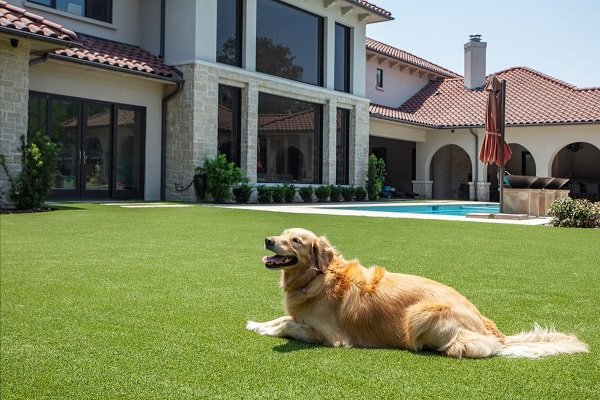Synthetic grass is a great alternative to natural grass for pet owners. It provides a safe and clean space for pets to play and eliminates the need for regular lawn maintenance. However, just like any other type of flooring, pet-friendly synthetic grass requires proper care and maintenance to ensure its longevity and durability.
In this article, we will discuss some effective tips on how to maintain pet-friendly synthetic grass and keep it looking great for years to come.
Regular Cleaning and Maintenance
Regular cleaning and maintenance are essential for keeping pet-friendly synthetic grass in good condition. Here are a few steps you can take:
- Remove debris: Regularly pick up any pet waste, leaves, twigs, or other debris that may accumulate on the synthetic grass. This can be done using a garden rake, a pet waste scooper, or simply by hand.
- Hose down: Use a garden hose to spray down the synthetic grass. This will help remove any dirt or dust that may have accumulated on the surface. It will also help keep the grass looking fresh and clean.
- Use a mild detergent: If there are any stubborn stains or odors on the synthetic grass, you can use a mild detergent specifically designed for artificial turf. Dilute the detergent with water and scrub the affected area with a soft brush. Rinse thoroughly with water afterwards.
- Prevent urine odors: If you have pets that regularly use the synthetic grass as a bathroom, you may notice urine odors over time. To prevent this, you can use a pet-friendly deodorizer or enzyme cleaner. Spray it onto the affected area and let it sit for a few minutes before rinsing off with water.
- Brush regularly: To maintain the appearance and longevity of the synthetic grass, it’s important to brush it regularly. This will help prevent matting and keep the blades upright. Use a stiff brush and brush against the grain of the grass for best results.
- Inspect for damage: Regularly inspect the synthetic grass for any signs of damage, such as tears, loose seams, or excessive wear. If you notice any issues, it’s important to repair them promptly to prevent further damage.
By following these steps, you can ensure that your pet-friendly synthetic grass remains in good condition, providing a safe and enjoyable outdoor space for both you and your pets.
Preventing Pet Damage
Pets can be rough on synthetic grass, so it’s important to take steps to prevent damage. Here are some preventive measures you can take:
- Choose a durable synthetic grass: Opt for a high-quality synthetic grass that is specifically designed to withstand pet use. Look for products that are labeled as pet-friendly or pet-resistant.
- Install a proper drainage system: Ensure that your synthetic grass has an efficient drainage system in place. This will prevent any accumulation of pet urine or water, minimizing any potential damage.
- Regularly clean and maintain: Regularly clean your synthetic grass by removing any pet waste and debris. Use a hose or a mild cleaning solution to remove any odors or stains. Additionally, regularly brush the grass to maintain its appearance and prevent matting.
- Train your pets: Train your pets to use a designated area for their bathroom needs. This will help reduce the chances of them causing damage to your synthetic grass.
- Provide alternative areas for pets: design designated play areas or provide durable toys and scratching posts to divert your pets’ attention away from the synthetic grass.
Avoid Excessive Heat
High temperatures can cause synthetic grass to become hot and uncomfortable for pets. Here are some tips to avoid excessive heat:
- Choose a lighter-colored synthetic grass: Darker colors tend to absorb more heat from the sun, making the surface hotter. Opting for a lighter shade can help reduce the temperature of the grass and make it more comfortable for your pets.
- Install shade structures or umbrellas: Providing shade over the synthetic grass can help protect it from direct sunlight and lower the temperature. This can be achieved by installing shade structures like pergolas or placing umbrellas strategically around the area.
- Use a misting system or sprinklers: Installing a misting system or sprinklers can help cool down the synthetic grass by creating a refreshing mist or spraying water onto the surface. This can provide relief to your pets and prevent the grass from getting too hot.
- Keep the grass clean: Regularly cleaning the synthetic grass can help maintain its temperature. Removing any debris or dirt can prevent it from trapping heat and becoming uncomfortably hot for your pets.
Regular Brushing and Fluffing
Regular brushing and fluffing are important for maintaining the appearance and integrity of pet-friendly synthetic grass. Here’s what you can do:
Professional Maintenance
While regular cleaning and maintenance can go a long way in extending the life of pet-friendly synthetic grass, it’s also a good idea to schedule professional maintenance at least once a year. Professional maintenance includes:
Conclusion
Maintaining pet-friendly synthetic grass requires regular cleaning and maintenance, preventing pet damage, avoiding excessive heat, and scheduling professional maintenance when needed. By following these tips, you can ensure the longevity and durability of your synthetic grass, providing a safe and enjoyable outdoor space for your pets to play and relax.

